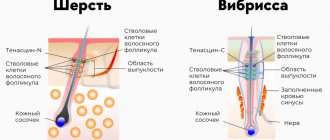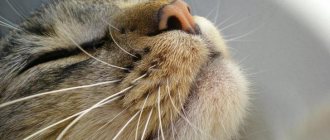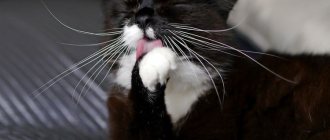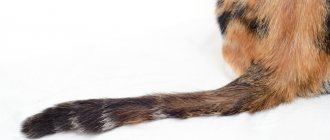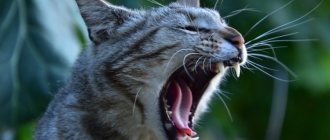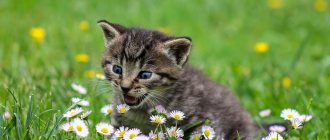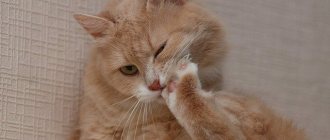Cats are considered one of the most common pets. Since ancient times, they have accompanied man, protecting his home from rodents and bringing peace and good mood to him. Despite this, cats have been and remain one of the most mysterious pets. After all, even after living next door to your pet for many years, a person can only tell you so much about it and its habits. For example, not every professional breeder, not to mention the average person, has a clear idea of why a cat needs a mustache and a tail and how it uses these organs.
Beauty and charm
For most owners, these are the qualities that are decisive when choosing a pet cat. Animals are used less and less to fight rodents and are increasingly perceived as living toys. But even if a kitten was born and raised in ideal conditions, has not seen the street in the third generation and has never needed anything, the instincts of a wild animal will still awaken in it, at least occasionally.
It is for this reason that pet fluffies sometimes upset their owners with little pranks, tearing soft toys to pieces, scratching wallpaper or jumping on curtains. This happens even to the most thoroughbred individuals. After all, no matter how cute, affectionate and good-natured a kitten may be, it is first and foremost a predator. And only then - everyone’s favorite, a living toy or decoration of the sofa in the living room.
And yet why is it needed?
The importance of a tail for a cat as a hunter living in the wild is difficult to overestimate.
This organ is used by the beast in completely different ways, depending on the circumstances and situation. It is well known that by looking at a cat's tail, you can easily understand what state of mind its owner is in, what is on his mind and what actions he intends to take in the near future. That is, this part of the body is considered as an indicator of mood. But it turns out that these are not all functions. When fighting for territory, a female, or something else, cats often sort things out using sounds and their own bodies, including their tail. It doesn't often come to a real fight. As a rule, the one with the steepest arched back or bushiest tail wins.
The tail also allows the animal to navigate in space at night (in conjunction with the mustache) and balance while jumping, climbing trees or fences.
Symptoms of the disease
Fat tails are much more common in male cats than in male cats. As noted above, animals with short fur are at risk, which complicates the diagnostic process. Let's try to find out what signs clearly demonstrate this disease:
- The epithelium at the base of the fur becomes lumpy, it flakes off and becomes covered with a thin crust of pus.
- The tail, most often at the junction with the body, is thickly covered with fat, which makes the fur begin to shine. The discharge cannot be washed off with shampoo or soap.
- If the disease progresses, the skin at the site of localization will be combed and covered with red pimples. This is how the animal tries to relieve the itching, but only spreads the infection through the skin.
- The area of “greasy” fur becomes exposed over time. This is due to the fact that the hairs gradually break off at their base.
- A symptom that the anus is inflamed may be uncharacteristic behavior when the cat crawls with its butt on the carpet, trying to release excess contents.
- Over time, brown spots may appear on your pet's tail; if left untreated, they will develop into a hard crust, tearing which the cat will injure itself.
Owners who notice that their animal has developed “greasy tail” syndrome should under no circumstances dismiss this problem, attributing it to seasonality or simply the cat’s untidiness. Most often, the true cause lies precisely in a serious illness that has just begun to manifest itself. If you react promptly, it will save a lot of hassle for both the owners and the cat.
Treating a cat's fatty tail is a long and tedious process. You need to start with a trip to the veterinarian, who will determine exactly what caused the disease and how to eliminate it as quickly as possible. Treatment, as a rule, is based on the fact that the pet begins to take baths more often. To do this, you need to buy special shampoos containing lactic acid. This will perfectly exfoliate harmful keratin accumulations and cleanse the skin, which will create the basis for subsequent therapy.
If the veterinarian determines that the greasy tail is caused by a hormonal disorder, then castration of the pet or medication to stop the production of sex hormones will be required. Excessive production of anal secretions is treated with rinsing. The specialist will clearly explain to the owners how this is done. If the disease recurs regularly, the anal glands can be completely removed surgically.
Best articles: Fighting external parasites in cats: drops on the withers
If the causes are caused by external irritants, then a complex of vitamins and a special diet are prescribed to strengthen the immune system. All this will help the cat become beautiful again, and its owner - calmer. If you ignore the fact that your pet’s tail becomes fat, then in the future this can lead to complete baldness, which will make the animal completely unsightly.
Fat tail on a cat treatment
Tail and cat mood
According to ethologists, cats never hide their thoughts and attitude to what is happening. And to understand what exactly an animal thinks and how it reacts, you need to take a close look at it. This is why a cat needs a tail - to explain to others its intentions, mood or well-being.
So, if the animal is comfortable, it is resting or just sitting, feeling safe, then this organ will lie straight, without moving, or wrap around its paws. By raising its tail vertically upward (or bending it slightly, like a question mark), the cat demonstrates its friendliness. In this way, she lets people or other animals know that she is glad to see them.
Quite often you can see a picture where a cat seemed to be going about its business, but suddenly stopped, as if lost in thought. If the tip of the tail twitches a little, the animal has seen or heard something interesting and is trying to understand what is happening, showing its interest.
However, such behavior when stroking fur should alert a person. Especially if all attention is paid to the hand. The cat is not angry, but believes that she is being flirted with, so she may respond with teeth or claws.
Animals also show playfulness or sexual arousal with their tail, smoothly moving the entire limb. Moreover, the greater the amplitude and the more persistent the wobbling, the more pronounced it is. However, there are no sudden jerks.
When an animal is angry or irritated, it immediately becomes clear why the cat needs a tail. He begins to twitch from side to side, showing nervousness with his entire appearance. If the cat is angry, the tail fluffs up and hangs to one side. At the same time, the animal arches its back and can growl or hiss, trying to drive away the enemy. It is better to stay away from the animal in this position.
Breed characteristics
The cold climate and high humidity greatly affected the formation of the special features of British cats. It is because of this that they have such thick fur and dense undercoat, which protect the four-legged animals from low temperatures. Nevertheless, excessive “fluffiness” or, conversely, too short hair is considered a deviation from the norm. Therefore, we will tell you about the breed standards of British cats:
- the skull is wide, making the head look like a perfect round ball. The British also have peculiar cheeks, which is why the muzzle also looks round and slightly flattened;
- The eyes are set wide and have a perfectly round shape. The color of the eyes sometimes depends on the coat, but generally they are orange or golden in color with a dark rim and brown spots;
- The British nose is quite wide and small;
- Compared to the size of the head, the ears are quite small, have rounded tips, and are set wide and low;
- The body is quite large, the chest is voluminous. It is also worth noting that these cats, as excellent hunters, have well-developed muscles. So, if they run, jump and perform other “acrobatic” tricks, then they do them very skillfully;
- The limbs are quite strong, but short. And of course, everyone’s favorite part - the round and soft paws, with good hair between the pads;
- the tail of the British is thick and quite fluffy (especially in those moments when they are scared);
- If we talk about weight, it is quite impressive: adult cats weigh about 10-13 kilograms, and male cats - 6-9 kilograms.
As we said earlier, these cats are very well protected from the cold by their dense undercoat. The British fur itself does not adhere to the body, and if you stroke a cat, you will be surprised at how pleasant and literally plush they are to the touch.
By the way
The British coat is not always short. There are also cats with long hair. However, the parents of such a kitten must also have long hair.
We would like to immediately draw your attention, taking into account all the above characteristics of this breed, that British cats and Scottish cats (Scottish Straight) are two completely different breeds. Don't confuse them.
Now let's talk about color. If you thought that the British only come in blue, then we want to make you happy - no. There are a huge number of coat color options for these four-legged animals, let’s try to list them all:
- blue - the coat color is smoky gray without any spots, the skin also has a blue tint;
- lilac - yes there is such a thing. This coat shade is achieved through a combination of blue and pink. By the way, the nose and paw pads will also be purple;
- chocolate is a very beautiful and rich color. Taking into account the size of the British cats, cats of this color will suit the most real aesthetes;
- charcoal black is a rather difficult color for breeding kittens, since over time the fur of babies fades, acquiring a gray tint;
- white - these cats cannot have spots or inclusions of a different color. The coat tone is usually cool, and the skin, nose and paws are soft pink;
- cinnamon - strongly resembles the color of cinnamon. One of the varieties of brown color;
- faun - the name is truly magical, in fact, like the appearance itself. The shade of the fur seems to have been achieved by mixing pink and creme brulee;
- smoky - this effect is achieved if the undercoat is several tones lighter than the main coat;
- silver chinchilla - the name speaks for itself. The coat has a very interesting color: the chest can be completely white, and on the back this shade gradually turns into a soft gray;
- golden - the coat is completely golden in color, but there are slight darkenings at the tips. Spots or patterns are not allowed;
- tortoiseshell - characteristic exclusively of cats. This color sometimes combines two or even three colors that evenly cover the entire body of your four-legged friend;
- tabby - cats with this color have spots and oddly shaped patterns all over their body. Moreover, the colors can be completely different: brown, gray, beige and white.
British cats also have spotted colors:
- bicolor - in this case, white color predominates on the coat, but it is important that it does not occupy more than half of the entire body;
- harlequin—predominance of white (at least 5/6);
- color point - the fur of a quadruped has two shades, among which the majority is white.
It is worth noting that British Longhairs can also have colors in a variety of shades and variations, but white and color point are not typical for them.
pixabay.com/
Balancing
Cats are great at climbing trees, jumping and successfully falling from a decent height. Maneuvering with its entire body and especially its tail during flight, the animal always lands on its paws. Thanks to this feature, falling from the 2nd, 3rd or even 5th floor often ends in nothing more than a slight fright. That's why a cat needs a tail - to jump far and land successfully. Moving along a thin branch or board and balancing with it, the animal perfectly maintains its balance. But this does not mean at all that a cat without a tail will not be able to jump far or will certainly break if it falls. In some breeds this organ is very short or absent altogether. It happens that a cat loses it as a result of injury or other circumstances. Over time, the animal adapts and continues, although not so comfortable, but quite a full life.
On the hunt
Watching an animal chase its prey, you can immediately understand why a cat needs a tail. After all, it is with its help that it can dramatically change its trajectory and overtake the target. During a hunt or chase, cats often use their tail as a rudder, which allows them to make sharp maneuvers without slowing down, not to mention jumping.
This technique is also used by larger fauna in the wild. Big cats (leopards, cheetahs, tigers) have much longer and stronger tails than ordinary pets. And they use them to their full potential, controlling their bodies in pursuit of prey and during long, complex jumps.
Health indicator
The condition of the coat can explain a lot about your pet’s health and tell you what illnesses it may have. With a lack of vitamins and nutrients, hair begins to fall out at the very base. In this case, it is necessary to normalize the animal’s diet. A sufficient amount of microelements and vitamins must be supplied to his body.
When the fur falls out along its entire length, the cat may have a fungus, allergies, lichen or lice. If you start to go bald, there may be digestive problems, eczema or dermatitis. Under severe stress, hair can also fall out.
Important! The appearance of the first signs of health problems is an important reason to seek qualified help from a specialist. All types of therapy and processing should only be carried out by a veterinarian.
And the fan and the blanket
Besides balancing and communication, there are other (less remarkable) uses for a cat's own tail. In the summer heat, for example, you can see how the animal, stretched out in the shade, gently swings it over its own body. Thus, the cat tries to cool itself by moving air currents and creating a semblance of wind (based on the principle of a fan).
If the room is cold, the animal curls up into a ball, trying to minimize heat transfer. In this case, the tail often wraps around the body and covers the muzzle. It turns out that the animal uses the warmth of its own fur like a blanket, covering frozen areas (nose, paws).
It turns out that there is no clear answer to the question “why does a cat need a tail?” This is not just a beautiful, but also an extremely important organ, serving as a means of communication and a balancer, a fan and a blanket, and sometimes even a toy for the young. Knowing exactly how the animal uses it, and understanding what it wants to say with this or that movement, the owner can significantly improve their relationship with the pet.
Interesting facts about tailed animals
Kitties have the ability to bring comfort to the home, but they are also able to heal the inhabitants of the house, calming their nervous system with their purring. They sleep for two thirds of their lives.
Other interesting facts are known:
- The largest cat in the world is the liger, growing up to 4 m and weighing up to 300 kg, and the smallest is about 0.5 m and 1 kg.
- The Turkish Van breed has a waterproof coat, which allows it to swim calmly in the water and not get wet.
- Cats have a unique phenomenon - they can find a home even when they are at a great distance from it.
- Increased sensitivity to vibrations allows cats to feel tremors 10 minutes before the start of an earthquake.
The liger is not afraid to swim in water because it does not get wet

